Seeking a unified home for your chickens and ducks? Our updated 2025 chicken and duck coop combo offers a streamlined backyard farming solution. This coop is designed for easy access and maximum comfort. It provides a cozy and thriving environment for both species. Enjoy a simple, practical solution for all your poultry housing needs!
Designing a Functional Coop Layout
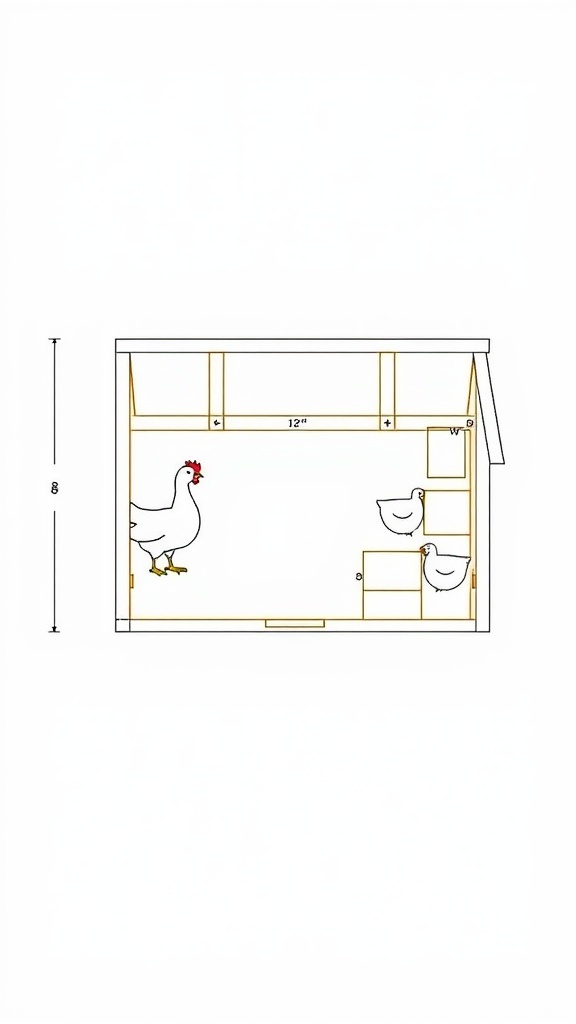
Planning a combined chicken and duck coop? Consider the layout carefully. This image showcases a straightforward design maximizing space. A spacious, uncluttered area allows your birds to move freely and remain healthy.
This coop offers separate areas for chickens and ducks. This design minimizes stress and promotes contentment for both species. Chicken perches are set at an ideal 12-inch height, providing a secure roosting spot off the ground.
Include nesting boxes for egg-laying, as shown. Ensure they are easily accessible for both your chickens and you. A well-planned coop simplifies daily tasks. With good organization, you’ll have more time to enjoy your chickens.
Creating a Safe and Secure Environment

Security is paramount when building a combined chicken and duck coop. This image showcases a robust coop with a strong fence, guaranteeing a safe roaming area for your birds. Observe the ducks and chickens inside, thriving in their protected and enjoyable habitat, shielded from potential predators.
A well-built coop needs a sturdy roof and walls. This protects your animals from severe weather conditions. The mesh fencing is a great addition. It allows airflow and keeps predators away. Regularly check the coop for vulnerabilities. This ensures ongoing safety and security.
Furthermore, a gap-free fence is crucial to prevent escapes. The image showcases a well-planned layout. Chickens and ducks can interact comfortably without overcrowding. Designating separate zones for each bird type within the coop minimizes stress and territorial issues. This promotes a harmonious environment.
Maintaining a clean and secure coop is vital for your chickens’ well-being. A tidy environment ensures happy and healthy birds. Consistent cleaning and upkeep are key to a flourishing coop in 2025.
Choosing the Right Breeds for Your Coop
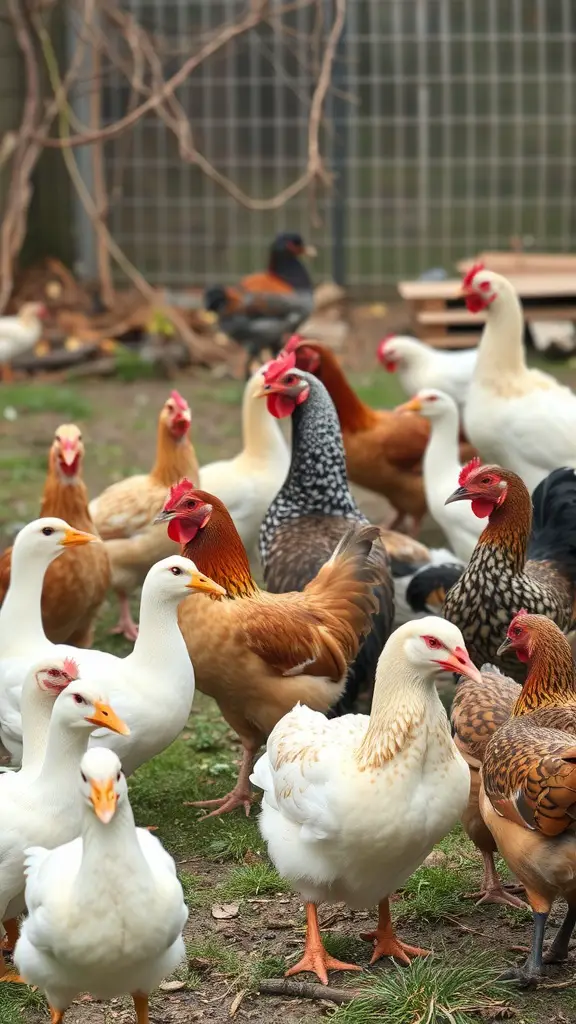
Combining chickens and ducks in one coop? Breed selection is crucial for success. The image showcases a vibrant mix of these birds. Each species adds unique traits and advantages to your backyard setup.
Chickens, similar to those pictured, are frequently selected for egg output and resilience. Rhode Island Reds and Leghorns are favored breeds due to their high egg yield. Conversely, ducks excel at pest management and also offer delicious eggs. Breeds such as Pekins or Khaki Campbells are worth considering for their amiable disposition and strong egg-laying abilities.
Consider how chickens and ducks will coexist. Some chicken breeds are assertive, while ducks are typically calm. A good balance promotes a peaceful coop. Ensure ample space and resources for their well-being.
Ultimately, remember to embrace the joy! Every breed boasts unique traits and personalities, enriching your backyard experience. Observe their playful interactions and natural behaviors with delight.
Providing Adequate Ventilation
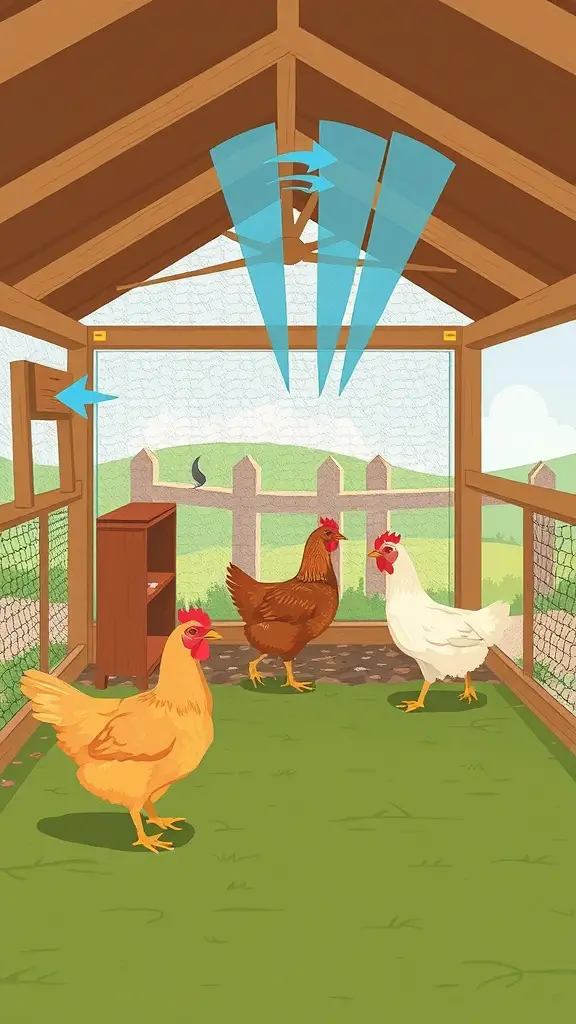
Proper ventilation is essential for a comfortable and healthy bird habitat. The coop pictured offers ample space for chickens and ducks. Its open design promotes excellent airflow, preventing stagnant air and moisture accumulation. This is vital for their well-being.
Effective coop ventilation is key for temperature and humidity control. This is crucial in summer, preventing overheating. Good airflow keeps your chickens and ducks cool, comfortable, and healthy.
This design showcases strategic openings and mesh, promoting natural ventilation and predator protection. Consider boosting this system with roof vents. These vents facilitate the escape of rising hot air. This upgrade dramatically improves the coop’s air quality.
Remember the coop door! Leaving it slightly open during the day promotes airflow. Ensure you close it at night to protect your flock from predators. Proper ventilation is vital for the well-being of your chickens and ducks. It’s not just a perk; it’s a necessity.
Managing Space for Roaming and Foraging
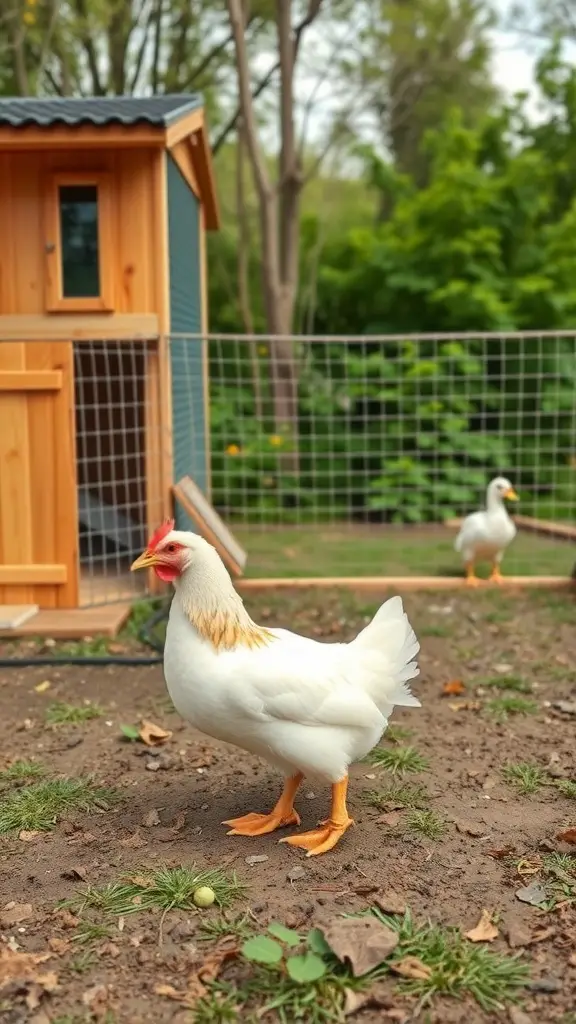
Combining chickens and ducks in one coop requires smart space planning. This ensures the health and happiness of your birds. The picture showcases a thoughtfully built wooden coop, offering both protection and security. The surrounding open space lets chickens and ducks move around easily, which is vital for their overall health.
Chickens and ducks are natural foragers. They love to scratch and peck, searching for bugs, seeds, and tasty greens. Your yard’s dirt and grass provide exploration and a natural food source. This keeps them active, reduces boredom, and boosts their overall well-being.
Design your chicken coop with ample space. Birds need room to move freely. Offer both shaded and sunny areas. This allows for relaxation and play. Strong fencing is vital. It protects against predators. It also provides sufficient exercise space.
Offer your chickens and ducks a secure, roomy habitat. This promotes natural behaviors and improves their well-being. Keep their environment stimulating by frequently rearranging the setup or adding new pecking objects. Contented birds are more productive!
Essential Coop Features for Mixed Species
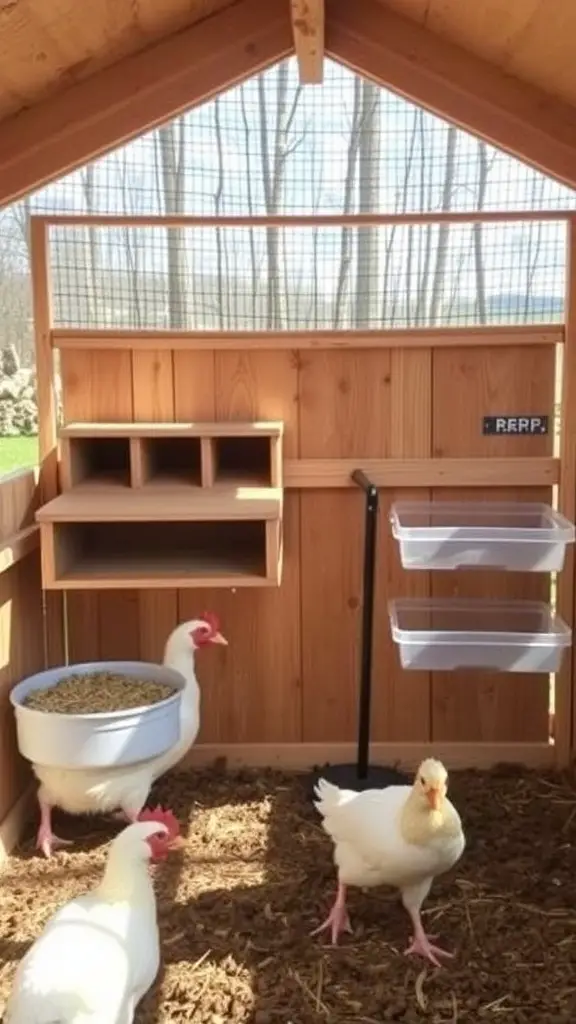
Creating a shared coop for chickens and ducks requires careful planning. This image showcases a coop designed to meet the specific needs of both species, promoting their comfort and security in 2025.
This design features a large, open space for birds to roam comfortably. The robust wooden frame offers reliable protection from the weather. The mesh roof ensures excellent airflow and ample sunlight. This is essential for maintaining a clean and appealing habitat.
A crucial element is the feeding zone. The picture shows a sizable bowl brimming with feed. This ensures both chickens and ducks can easily access their food. Providing ample space is key. This prevents overly aggressive competition during mealtimes.
This coop includes supply storage, ensuring excellent organization. A clean, well-organized coop promotes happier, healthier birds. Plus, it simplifies routine maintenance.
Furthermore, easy cleaning is a major advantage. This design promotes a healthier environment, minimizing disease risks. In conclusion, a well-planned coop design enhances the experience of raising chickens and ducks.
Watering Solutions for Ducks and Chickens
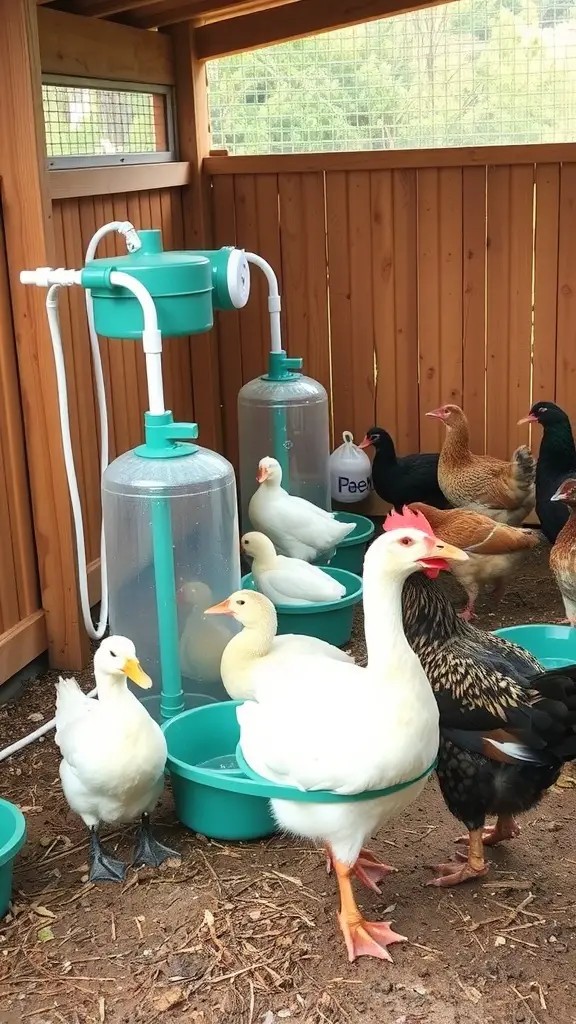
Maintaining proper hydration is crucial for the well-being of your ducks and chickens. This image showcases an efficient watering setup designed for both species. Notice the transparent containers brimming with clean water, guaranteeing easy access for all birds and preventing congestion. This updated system reflects best practices for poultry care in 2025.
This innovative setup includes a central water source linked to separate drinking bowls. Ducks and chickens can easily drink together, minimizing water-related conflicts. The design is both functional and hygienic, keeping the water clean and preventing mud.
Streamline your coop setup by using consistent watering methods. This saves valuable time and reduces effort. It also promotes bird health by ensuring a readily available source of clean water. Maintaining a clean water supply is crucial, particularly during hot weather. Both ducks and chickens are susceptible to dehydration.
Implementing such a system can also decrease how often you need to change the water. Effective filtration keeps the water cleaner for extended periods. This translates to less maintenance for you, all while guaranteeing your birds stay hydrated. Content birds result in improved egg production, making it a worthwhile investment in 2025!
Feeding Strategies for Different Nutritional Needs
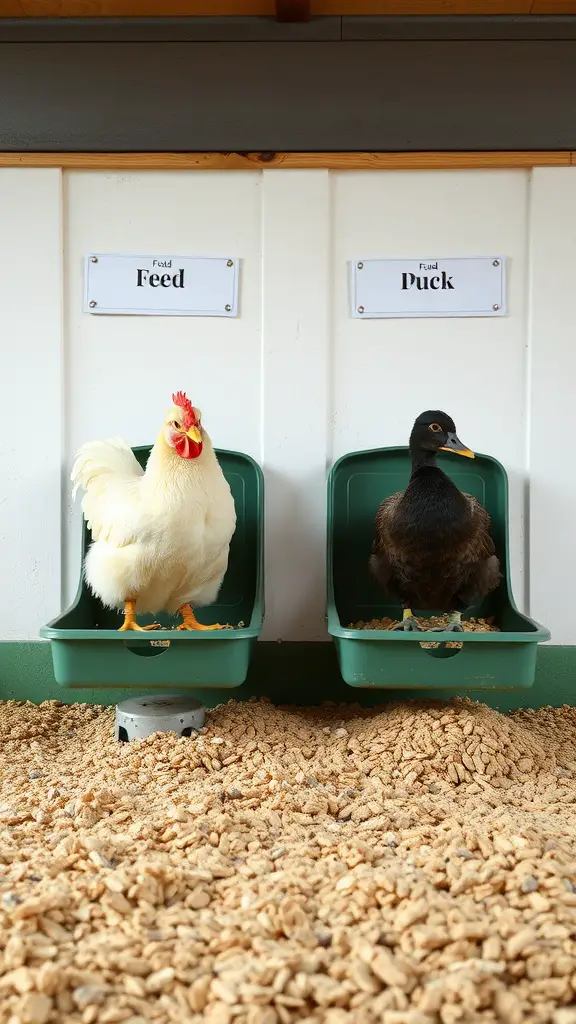
Raising chickens and ducks together requires understanding their distinct dietary needs for optimal health. The image showcases a chicken and a duck at separate, clearly marked feeding stations. This arrangement guarantees each bird receives the correct feed, emphasizing the significance of customized nutrition plans.
Chickens flourish with a diet full of grains, proteins, and vital vitamins. Quality chicken feed often contains corn, soybean meal, and key minerals. Ducks, however, need a slightly adjusted diet. They thrive on higher protein intake, plus more greens and aquatic plants. Duck feed usually blends grains and may include mealworms for extra protein.
Individual feeding zones, like those pictured, simplify tracking each bird’s consumption. You can then fine-tune their diets accordingly. Chickens might focus on their feed, while ducks explore different options. This approach respects their unique eating habits. It also minimizes food competition and reduces stress among your flock.
Always review the nutritional information of your chosen feed. Select feeds designed for chickens or ducks. Enhance their diet with safe treats like fruits, vegetables, or grains, but in moderation. Thoughtful feeding ensures a thriving, healthy chicken and duck flock.
Nesting Boxes for Clucking and Quacking
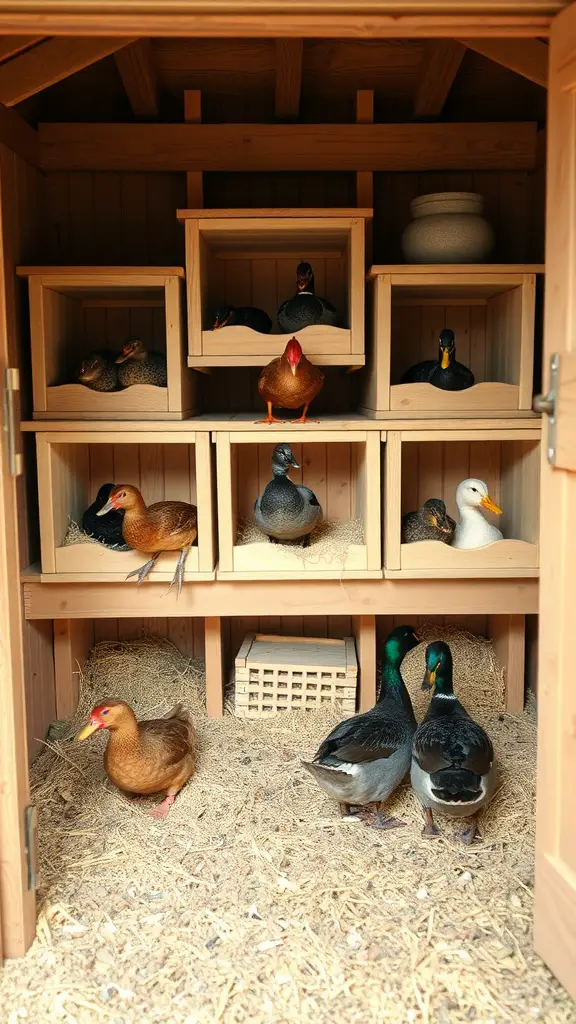
In 2025, nesting boxes remain crucial for happy chickens and ducks sharing a coop. This image showcases a well-designed space. Separate wooden boxes provide a secure and comfortable egg-laying environment for each species.
These boxes are carefully organized, maximizing space. Each box contains straw, offering cozy bedding for the birds. This design encourages birds to select their own nesting location, minimizing stress and fostering a peaceful setting.
Choosing the correct nest box size is crucial for each bird. Chickens require adequate space, while ducks thrive in slightly bigger boxes. Providing separate boxes for each species avoids overcrowding and maintains cleanliness.
This coop combo excels in easy cleaning. Its streamlined design allows for swift bedding removal, ensuring fresh nesting spaces. Maintaining cleanliness is vital for poultry health, preventing potential diseases.
Finally, think about where you put the nesting boxes. Choose a calm spot inside the coop, far from the main activity. This helps your chickens and ducks lay eggs peacefully, free from disruptions.
Health Monitoring for Chickens and Ducks
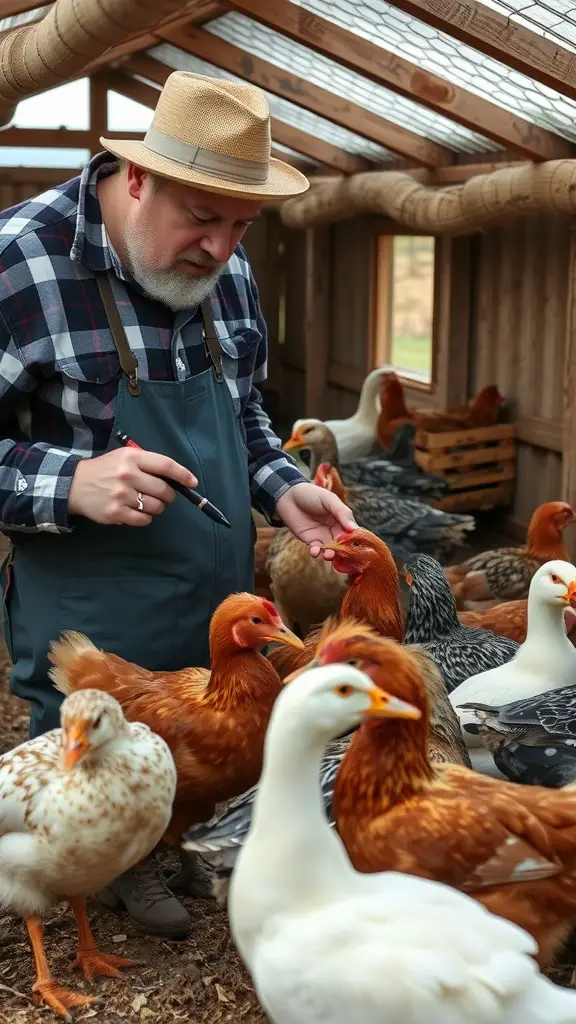
Maintaining the health of your chickens and ducks is crucial for their welfare. The image displays a caretaker engaging with an active flock, demonstrating practical health monitoring. This method enhances the connection with the birds and facilitates early detection of potential health problems.
Routine health assessments are crucial. Watch for any indications of sickness. These include shifts in behavior, appetite, or physical condition. The caregiver shown is thoroughly inspecting a chicken. This highlights a straightforward, yet valuable, technique for confirming each bird’s well-being. Observe the feathers, skin, and general energy levels closely.
Furthermore, a consistent routine promotes better organization. Think about maintaining a health record for each bird. Document your observations during your interactions, similar to the individual in the picture. This practice will assist you in monitoring any developments or shifts in their condition over time.
Regular parasite checks are crucial. Ducks and chickens are susceptible to mites and worms. Include this in your routine health checks. This proactive approach ensures a happy and healthy coop.
Understanding Behavioral Differences
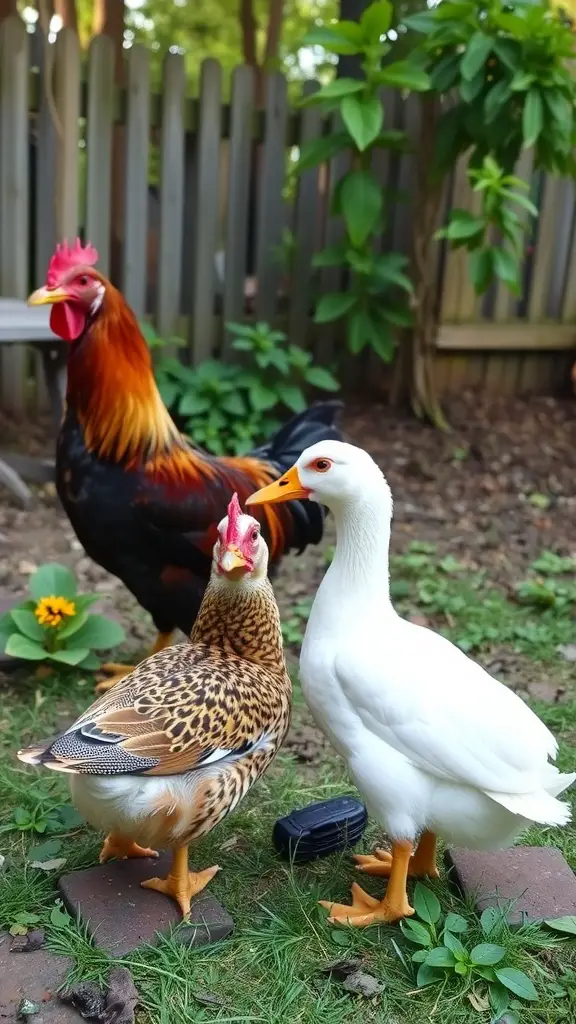
Combining chicken and duck coops requires understanding their distinct behaviors. Chickens and ducks can live together harmoniously. However, acknowledging their differences is crucial for success.
Chickens, by nature, are inquisitive creatures. They instinctively scratch at the earth, searching for tasty morsels. They flourish in social settings, creating a distinct pecking order. Ducks, even more sociable than chickens, delight in group activities. Their love for water is undeniable; they frequently dabble and forage near it.
This image captures a dynamic scene with a rooster, chicken, and duck. The rooster boasts bright, colorful plumage, asserting its presence. The duck, sporting sleek white feathers, appears to interact with the uniquely patterned chicken. Together, they create a peaceful atmosphere within the coop.
Understanding these behaviors allows you to design a harmonious space for both chickens and ducks. Offering distinct feeding areas minimizes rivalry and anxiety. Also, guaranteeing a water source keeps ducks content, while chickens can freely forage in the vicinity.
Seasonal Adjustments for Coop Comfort

The photo showcases a charming chicken and duck coop, nestled in a snowy landscape. The coop boasts a sturdy and welcoming design, featuring a beautiful wood finish. Several birds peek out, their curiosity piqued by the wintery scene.
With the changing seasons, adapt your bird care for their well-being. In winter, insulate the coop to block cold and retain warmth. Use straw or hay bedding for added comfort and warmth.
As spring arrives in 2025, the snow melts, and birds eagerly explore. Now is the perfect time to clean the coop and inspect it for repairs. Fresh bedding and good ventilation will eliminate any winter dampness.
Summer demands specific care. Provide ample shade and fresh, cool water. Consider a dust bath; it helps chickens stay cool and clean.
As autumn 2025 approaches, predator-proof your coop. Prepare for colder temperatures. Heat lamps or extra bedding can significantly improve comfort. Monitor your chickens closely throughout the year for optimal health.
Daily Care Routine for Mixed Flock
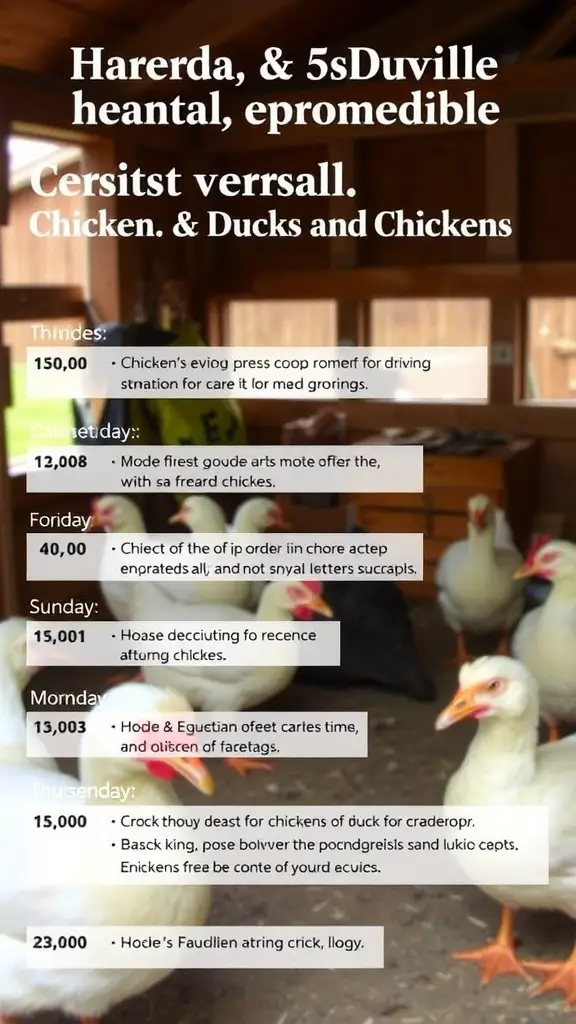
Raising chickens and ducks together can be enjoyable and fulfilling. Each species has specific requirements. Knowing these needs ensures a thriving and content flock.
Begin your day with a morning inspection. Confirm the safety of all birds in their coops. Refresh their food and water supplies. Remember, chickens and ducks need different diets. Offer suitable feed, ranging from grains to specialized pellets, to meet their specific nutritional requirements.
Now, let your birds explore! Chickens thrive by scratching and pecking. Ducks love to splash in water. A secure outdoor area is vital for their health. Watch them closely, especially at first. This prevents accidents and ensures their safety.
Maintaining a clean coop is crucial for your daily tasks. Regularly removing waste and refreshing bedding ensures a healthy living space. Chickens and ducks tend to create messes, making consistent cleaning essential. A clean coop directly contributes to the well-being and happiness of your flock.
As evening arrives, guide your chickens back to their coop. Look for any latecomers and ensure they’re secure for the night. This safeguards them from predators and provides warmth.
Prioritize your birds’ well-being. Watch for any indications of sickness or discomfort. Routinely inspect their plumage, eyes, and beaks. If you notice anything unusual, seek veterinary advice. Healthy birds ensure a flourishing flock in 2025.
Understanding Egg Laying Patterns
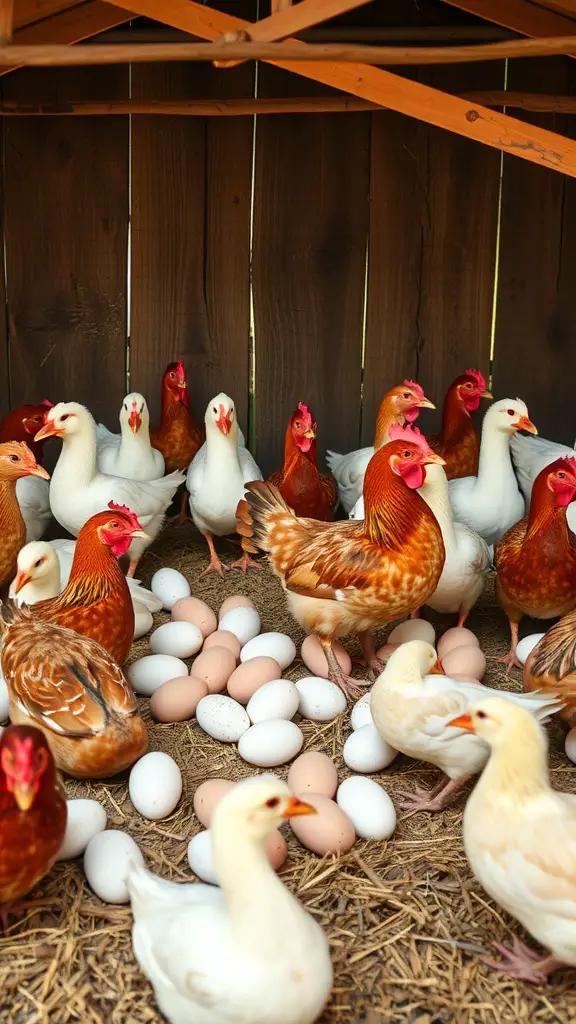
Inside a snug chicken and duck coop, a vibrant scene unfolds. Birds mingle amidst a collection of eggs. Chickens, adorned with colorful plumage, and ducks, standing with elegance, bring life to the space. Each bird contributes to this delightful setting.
For those planning a mixed chicken and duck coop, understanding their egg-laying habits is key. Chickens usually lay eggs every day, particularly in the sunnier, warmer seasons. A hen’s weekly egg production can range from three to six eggs, influenced by factors like breed and age.
Ducks offer a contrasting egg-laying schedule. They typically produce fewer eggs, around four per week. Seasonal changes and their habitat significantly influence their egg production. Interestingly, chickens and ducks can live together, but understanding their distinct laying patterns is key for managing your fresh egg supply effectively.
Imagine a coop brimming with eggs! It highlights the delight and usefulness of raising both chickens and ducks. Do you prefer the rich flavor of duck eggs or the classic taste of chicken eggs? Knowing their laying habits helps you maximize your flock’s potential.
Integrating Plants into the Coop Environment

Crafting a comfortable and practical space for your chickens and ducks is an enjoyable task. This image showcases a lovely design, integrating plants with your birds’ habitat. The greenery enhances the aesthetic appeal and provides advantages for the animals.
Adding plants enhances coop air quality and offers cooling shade. The pictured pots contain herbs and small plants. These can act as natural, tasty treats for your chickens and ducks. This is an excellent method to diversify their food intake.
Moreover, incorporating plants aids in natural pest management. Some plants possess insect-repelling qualities, promoting a healthier coop. Marigolds, for example, effectively deter pests and flourish in chicken coops.
Aesthetics matter! Brighten your coop with plants. They create a visually appealing space for you and your chickens. Observe the dynamic interaction between plants and animals. Enjoy the peaceful and vibrant environment they create together.
Dealing with Waste Management
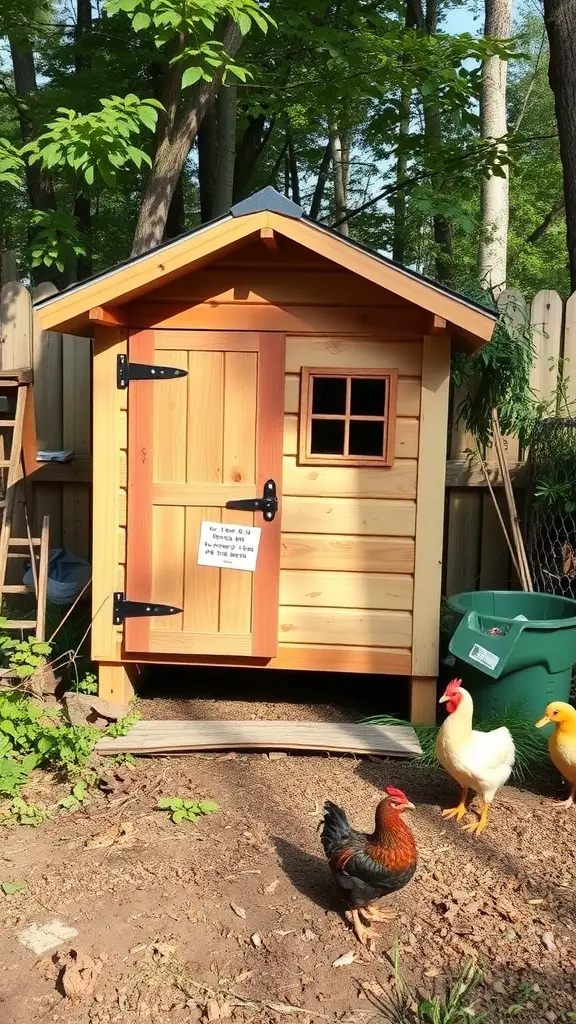
Handling waste in a combined chicken and duck coop might seem daunting. However, it’s manageable! The image showcases a robust coop, ideal for your birds. Maintaining a clean environment is crucial for their well-being and contentment.
Start with consistent cleaning. Clean your coop weekly, minimum. Remove all old bedding, droppings, and uneaten food. Keep a shovel and broom handy for quick and easy cleaning.
Think about using straw or wood shavings as bedding. They soak up moisture and manage smells effectively. After cleaning, compost the old bedding. This is a fantastic way to recycle and improve your garden soil in 2025.
A streamlined waste management system is key. Consider using a container similar to the one pictured for effortless waste disposal. This promotes organization and simplifies cleaning. Furthermore, it deters pests from entering the coop, ensuring a healthier environment for your chickens in 2025.
Finally, remember the outdoor spaces! Removing droppings outside is crucial. A clean ground promotes a healthier environment for your chickens and ducks. With a consistent routine, waste management becomes effortless.
Choosing Bedding Materials for Comfort

Creating a combined chicken and duck coop? Bedding is key for bird comfort. The image shows a snug area with soft bedding. This is vital for your flock’s health and well-being.
Choosing the correct bedding is key for moisture absorption and odor control. Wood shavings, straw, and hay are common and effective options. These materials offer comfortable cushioning and a warm resting area for your birds.
Shredded paper or wood pellets work well too. They simplify cleaning and upkeep, saving you time. Your chickens and ducks will love having a comfortable space to explore and enjoy.
Regularly change the bedding to maintain a fresh environment. A clean coop promotes happier birds and healthier eggs or ducklings. Choosing comfortable bedding is key to creating a welcoming home for your poultry.
Enhancing Coop Enrichment Activities
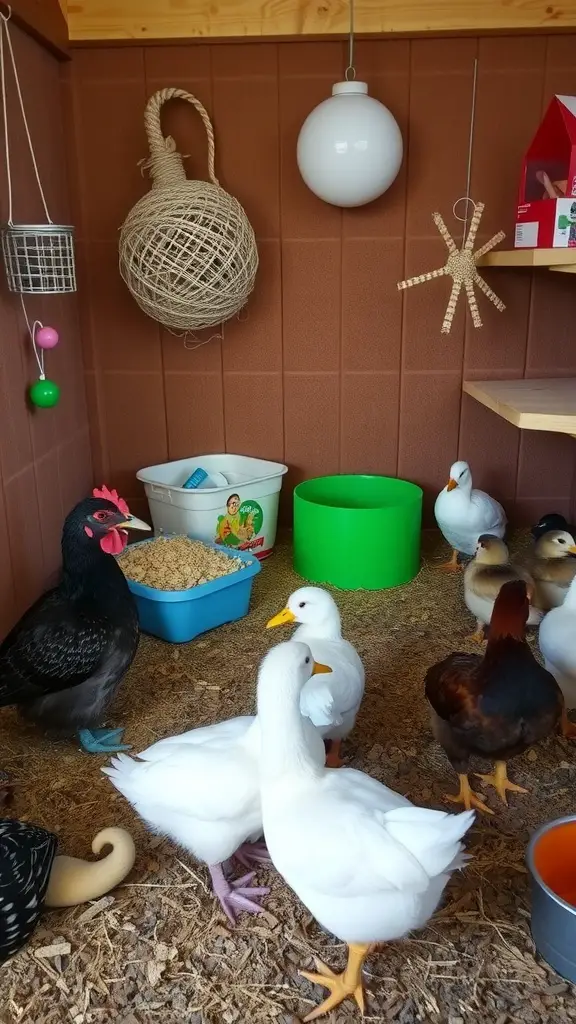
Providing an engaging habitat for your chickens and ducks is key to their well-being. This image showcases a comfortable coop. It’s equipped with various enrichment features. These activities stimulate the birds and keep them entertained, promoting a healthier and happier flock in 2025.
Hanging toys, such as the rope ball and star, are excellent for pecking and play. These toys promote natural instincts and prevent boredom. Boredom can cause stress and bad habits.
Diverse food and treat containers are essential for optimal chicken care. Strategically place grain mixes and snacks throughout the coop. This encourages natural foraging behaviors. It also keeps your chickens active and mentally stimulated, promoting their well-being.
A thoughtfully designed chicken coop offers more than just protection; it’s a stimulating environment. Adding enrichment like toys and diverse feeding spots greatly improves your chickens’ well-being.
Legal Considerations for Backyard Flocks
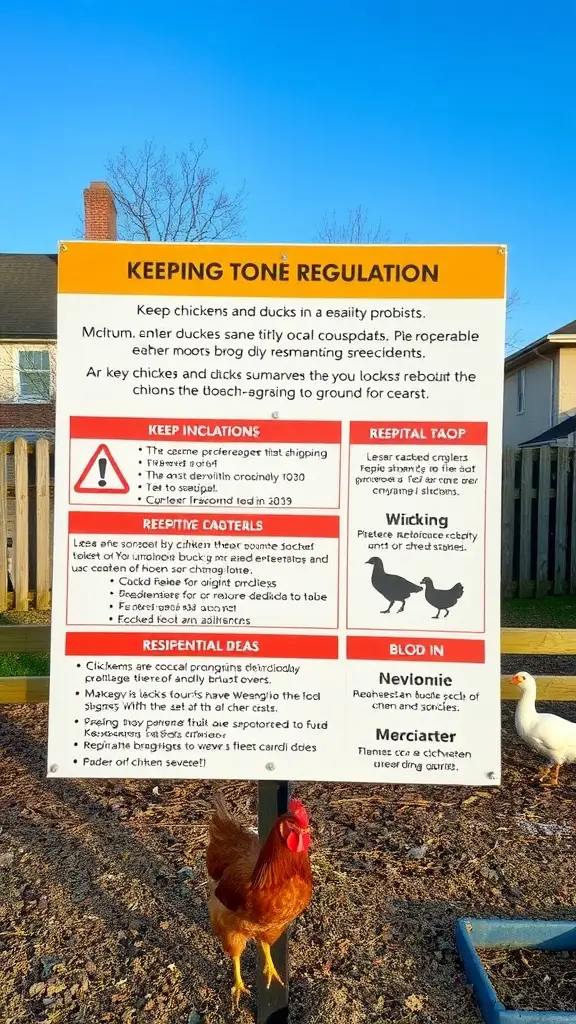
Planning to raise chickens and ducks together? First, check your local laws. The picture displays a sign highlighting key regulations for keeping these birds. Knowing these rules helps you stay compliant and avoid problems with local authorities.
Always verify your chicken coop setup aligns with local regulations. Numerous areas feature zoning laws impacting bird numbers, permit needs, and acceptable housing. This sign probably reminds you to confirm these local rules.
Consider noise ordinances. Chickens and ducks can be noisy. Check your local regulations. The sign highlights tone control. A peaceful environment is key for good neighbor relations.
Furthermore, prioritize health and safety. Ensure your birds have ample space, adequate shelter, and constant access to food and fresh water. The sign serves as a helpful guide for proper flock management, assisting you in adhering to all legal requirements.
Finally, anticipate and address potential concerns. Open and friendly communication with your neighbors about your chickens can prevent issues and foster a positive community relationship. This proactive approach is key to successful urban chicken keeping in 2025.
Building a Community of Chicken and Duck Enthusiasts
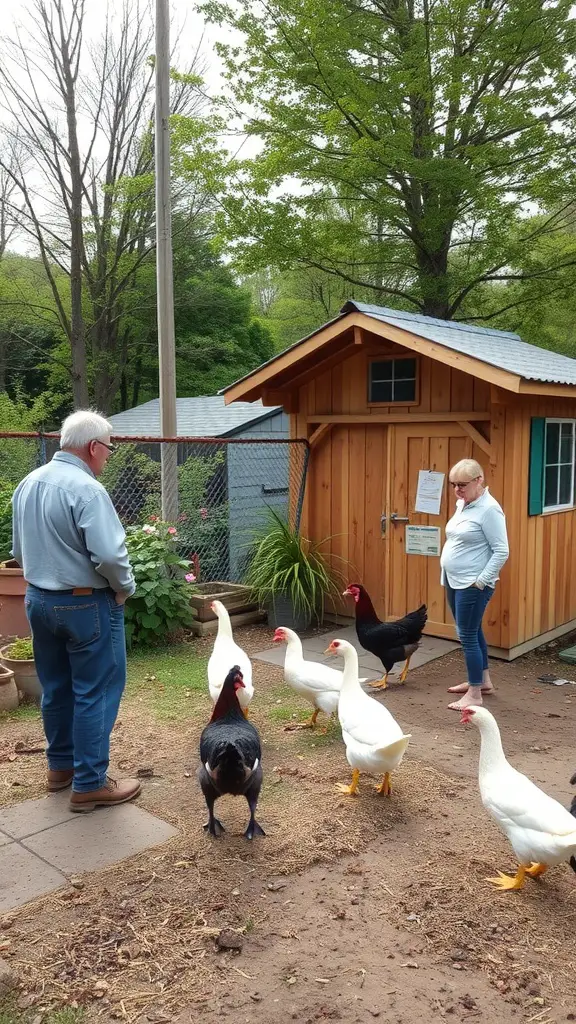
This delightful scene showcases two individuals interacting with a vibrant flock of chickens and ducks. Raising these endearing birds brings immense joy. The rustic coop in the background provides an ideal habitat for both species. It cultivates a strong sense of community among poultry enthusiasts.
In 2025, nurturing your poultry involves more than just animal care. It’s about building connections with like-minded individuals. Engage with local agricultural societies or online communities to meet fellow poultry lovers. Share advice, swap experiences, and perhaps even trade birds to enhance your flock’s diversity.
Organize local meetups! They’re perfect for sharing coop design tips, feeding strategies, and healthcare advice. Picture a weekend potluck featuring dishes made with farm-fresh eggs or duck products. It’s a great way to connect and celebrate your hard work.
In 2025, building your backyard flock is more than just raising birds. It’s about crafting a narrative. Your dedication to your chickens and ducks can spark interest in others. Share your poultry-keeping adventure! A simple social media post or a friendly conversation can encourage beginners to explore the joys of raising poultry.
Understanding the Cost of a Combined Coop
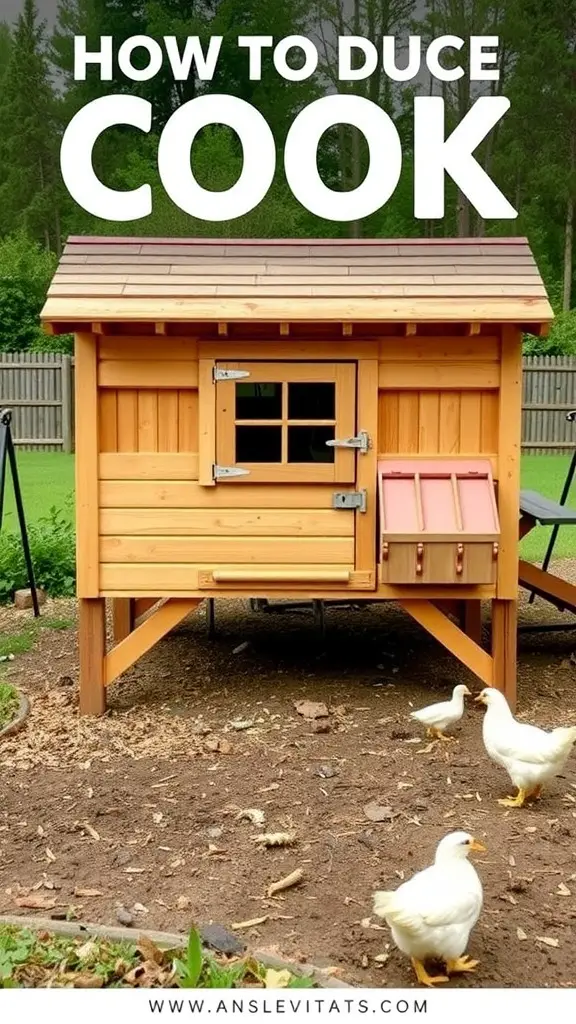
Considering a combined chicken and duck coop? It’s crucial to understand the expenses. This image displays a delightful wooden coop, perfectly suited for chickens and ducks. Its robust build and smart layout make it a desirable option for backyard poultry keepers in 2025.
Investing in a combination coop, whether built or bought, demands careful consideration. Your initial costs include materials or the purchase itself. A quality coop can cost anywhere from a few hundred to several thousand dollars. This depends on its size and features. Prioritize a coop that aligns with your budget and adequately houses your chickens.
Don’t forget about maintenance expenses. Routine cleaning, bedding changes, and consistent feeding will impact your budget. Factor these recurring costs into your financial planning. Also, prioritize excellent coop ventilation and weather protection. This proactive approach can minimize health problems and ultimately save you money.
Finally, remember the initial setup for your new feathered friends. Ducklings and chicks need special bedding, feeders, and waterers. Investing in these items early ensures a comfortable start for your poultry.
Transitioning to a Mixed Flock
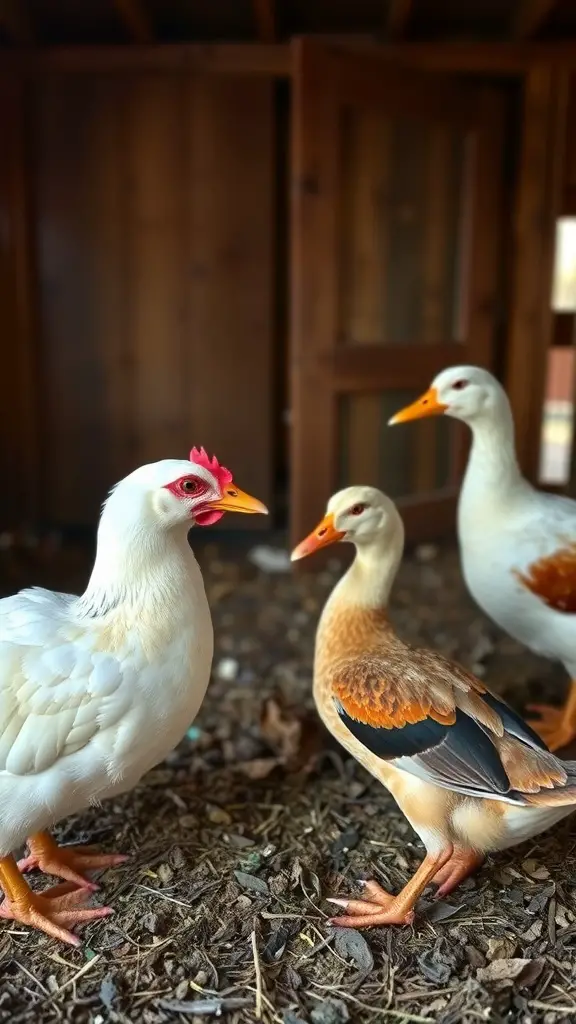
Integrating chickens and ducks into a shared backyard environment offers a rewarding experience for modern homesteaders. The photo features a chicken alongside two ducks, highlighting the dynamic interactions possible within a mixed flock. This pairing demonstrates the unique and engaging characteristics each species contributes to a backyard coop.
Integrating ducks into your existing chicken flock requires careful planning. Remember, chickens tend to be more social creatures. Ducks, on the other hand, often prefer a more solitary existence. However, with the proper setup, both species can live together harmoniously.
Begin by letting the animals acclimate to each other through a barrier. This allows observation without physical interaction. After one to two weeks, slowly introduce them in a supervised area. Closely monitor for aggression and be prepared to separate them immediately if necessary.
Adequate space is crucial for happy ducks. They are naturally messy and require water for their characteristic dabbling behavior. Make sure your coop offers plenty of room for comfortable movement. Observe how these ducks interact and form their social order, a normal aspect of settling into their new environment.
Shared meals can strengthen their bond. Provide a nutritious diet suitable for both species. This promotes their well-being and encourages interaction. Anticipate unique behaviors as they adjust to their combined group. Some might be more inquisitive than others, similar to the birds in this image.
In summary, combining chickens and ducks in one coop can significantly enhance your backyard farming journey. By being patient and attentive, you can foster a balanced habitat where both species flourish side-by-side.
Dealing with Predators and Threats
Keeping your combined chicken and duck coop secure is vital for your birds’ well-being. The image shows a serene yard with chickens and a duck, featuring a strong fence and a comfortable coop. However, remember that this inviting scene can also attract unwanted predators.
Common dangers to your flock include raccoons, foxes, and predatory birds. These animals can easily enter an unsecured coop. Make sure your coop doors fit tightly. Cover all windows with durable wire mesh. This added security is essential for your chickens’ safety.
Think about adding a roof to your chicken coop. It protects your flock from birds of prey. Plus, it offers vital shelter from severe weather. A sturdy roof significantly boosts your coop’s security.
Maintain a clean coop perimeter. Predators frequently use tall grass and dense brush for cover. A tidy area minimizes their hiding places. Inspect your fencing regularly for holes or damage. Even small openings can allow predators access.
Finally, think about installing motion-sensing lights or noise-making gadgets. These can surprise intruders and discourage them from approaching. With some forethought and work, you can establish a secure environment for your chickens and ducks in 2025.

